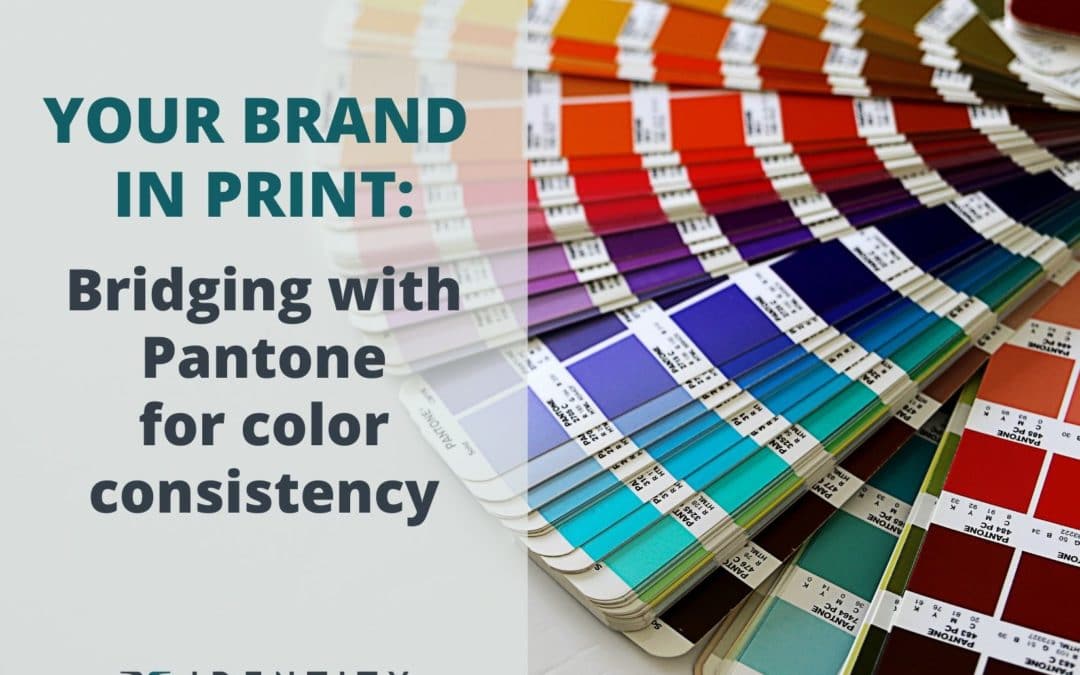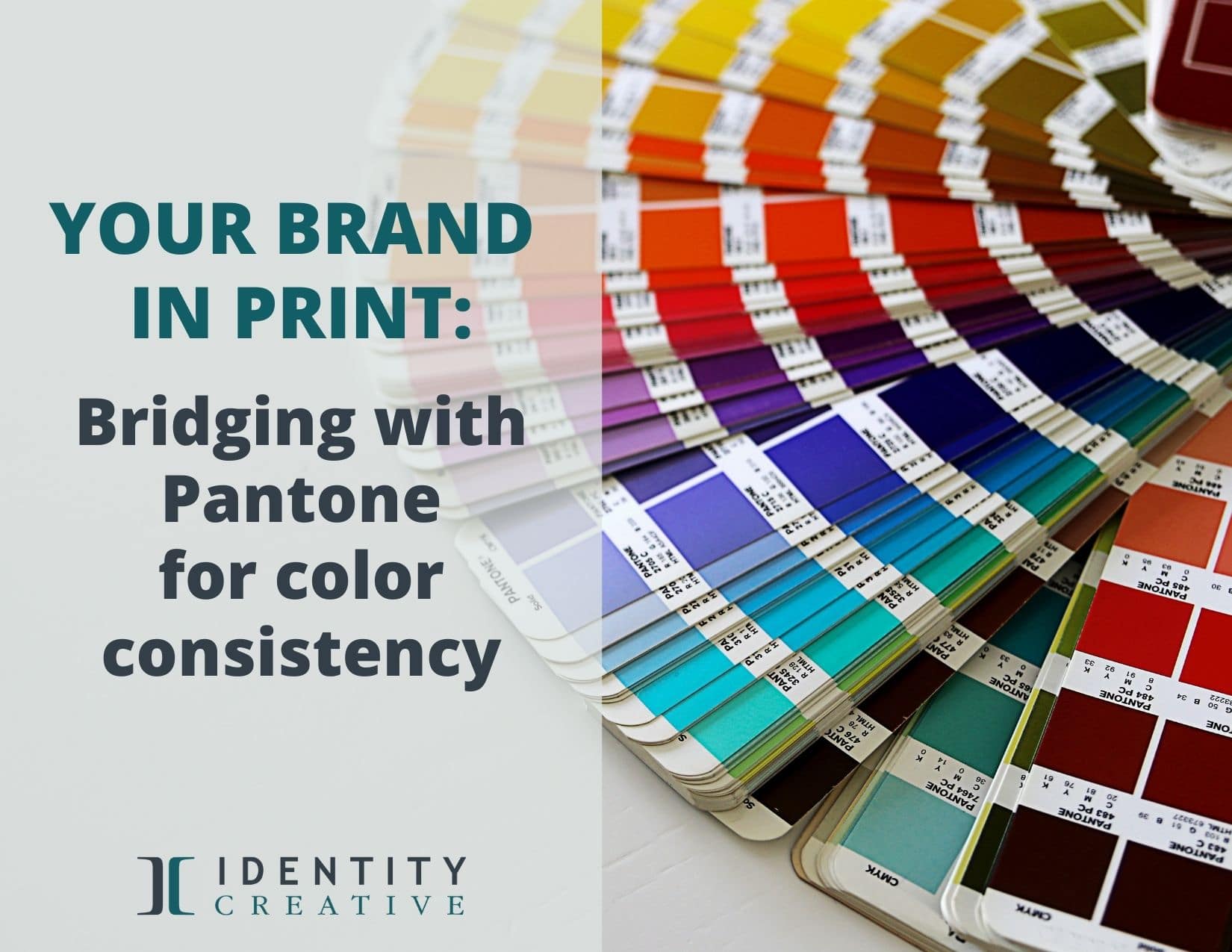
Color plays a vital role in the development of a brand identity.
Color impacts your brand’s perceived personality, recognizability, memorability, and market position. Your brand can “own” a color, and while you’re not likely to trademark it like Tiffany’s PMS 1837 blue, or UPS PMS 4975 brown, the right color will make your brand memorable.
Selecting the ideal brand colors that can be consistently reproduced across all media is critical.
This post will cover avoiding costly color mistakes, choosing the right color formula, and implementing it accurately for a professional, consistent, and impactful brand presence.
Choosing the wrong color formulas can cause your logo to have drastic inconsistencies in print.
Some color options present challenges when implemented consistently. You might not be able to put your finger on it, but a blue can take on a purple tint, a forest green has an olive tone, or an orange is too brown. Selecting the right colors for your logo will help you avoid this common problem.
When your logo is in print, does the color look wrong?
Have you ever had the color of your logo look flat, washed out, or simply wrong? You might not be able to put your finger on it, but it seems off. Maybe an orange looked brown, a blue looked purple, or a forest green had an olive tone. Selecting the right colors for your logo will help you avoid this common problem.
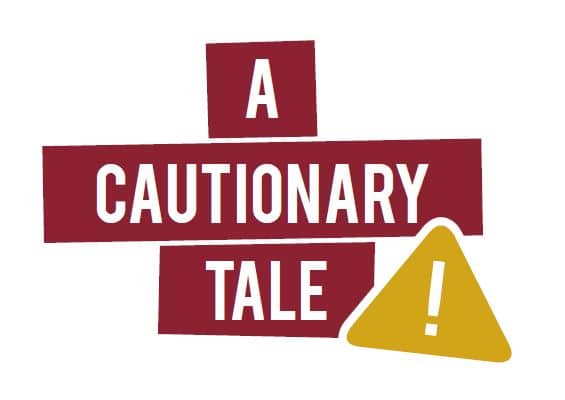
A Cautionary Color Tale: Our Color Calamity
In 2008, the owner of an HR benefits company asked us to rebrand his business. When the owner requested a Pantone Reflex Blue, we went with it.
Don’t Choose Logo Colors From a Screen. To save time, we presented his requested logo colors online. Colors on a screen are brighter and made visible with light, and they may look quite different when printed on paper.
Then, when the owner received his printed business cards, the vibrant PMS (Pantone Matching System) Reflex Blue looked more violet than blue, as shown below.

An example of PMS Reflex Blue on the screen than in process printed form.
The printed results were so disappointing.
Lesson learned: The CMYK formula for Reflex Blue had equally high percentages of magenta and cyan and cannot be replicated in four-color process printing.
To solve this issue, we returned to the PMS Color Bridge and explored color options that would present well in print. By selecting a good match between the PMS color and its comparable CMYK formula, we found a blue that the client loved and will be produced consistently across all media.

Color Matching: How Your Brand’s Colors Will Reproduce in Print
You want your brand’s colors to be produced consistently, from your standard in-house office printer to ‘process’ printing by a professional print house.
The Color Language of Professional Printers
Let’s dive into how brand colors should be selected and implemented online and in print. If you’re interested, I’ll start with a bit of history of the print world of color.
In 1963, Larry Herbert, developed the Pantone Color Matching System for the print industry to bring consistency to color printing worldwide. Think of it as Webster creating his dictionary to establish standards in the English language. His efforts to promote his books was immensely successful. While others have developed systems for consistent color application, printers, graphic designers, artists, web developers, architects, sign companies, fashion designers and interior decorators worldwide rely on Pantone’s system to achieve consistent color results.
Do you know your brand’s Pantone color off the top of your head? We took our Pantone book to our Benjamin Moore Paint Supply to get that exact Pantone 5473 teal for our office.
My Trusted Pantone Color Bridge
Since my early days as a designer, I always had my trusty Pantone Color books at my side. Pantone set the color standard since the pre-digital era: it was the color language spoken by every designer and printer. In 2022, Pantone introduced Pantone Connect and phased out the pre-loaded color libraries in the Adobe Suite. I take a look at reviews of Pantone Connect and share some workarounds for working with Pantone in Adobe here.
Understanding the difference between PMS (Pantone Matching System) colors and Process or CMYK colors is essential to the all-important brand consistency everywhere your brand is seen. A solid understanding of each print method can save you major printing headaches for years.
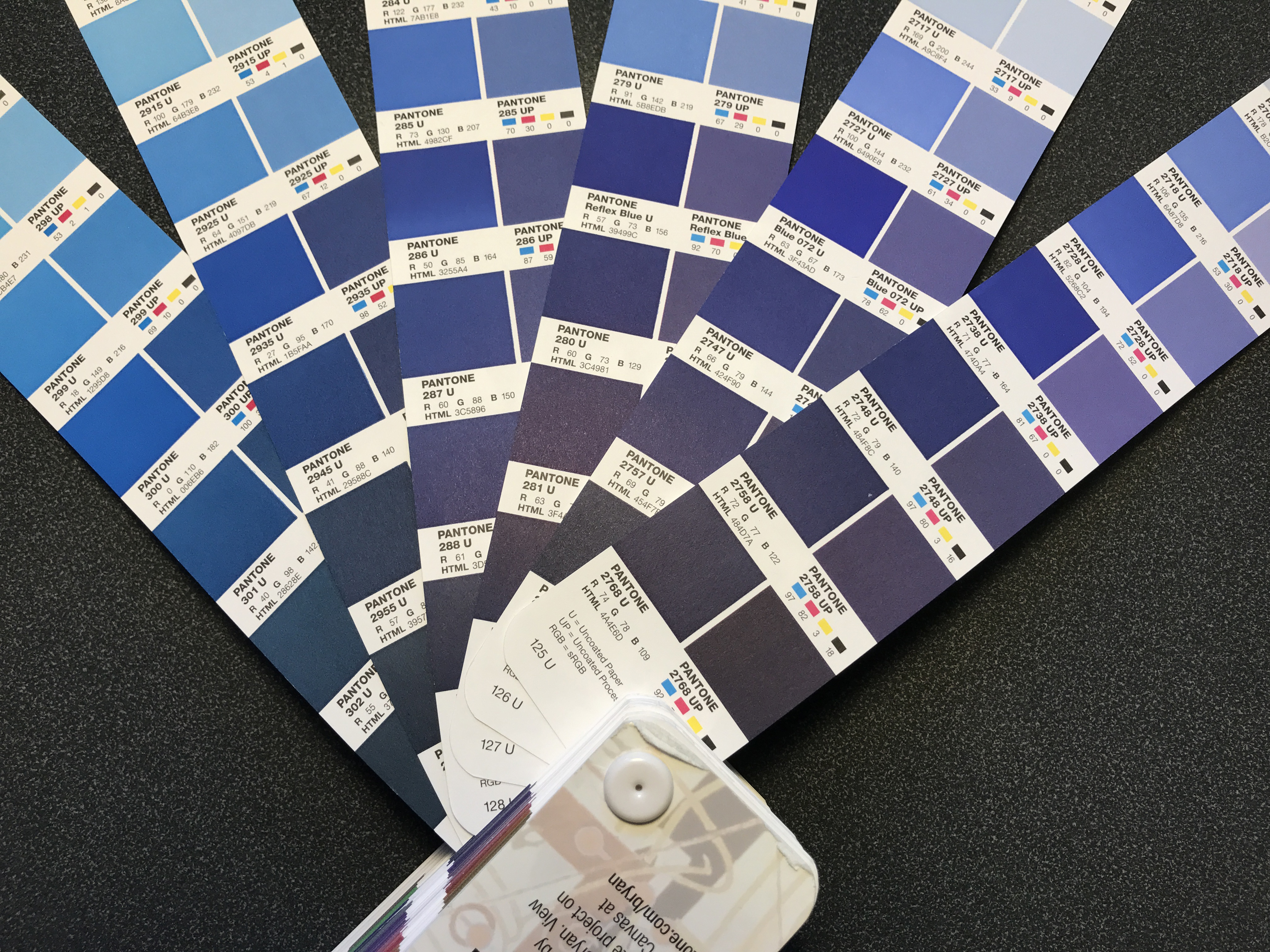
A color bridge compares PMS inks to CMYK inks.
Color Formulas and Your Brand
Let’s cover a few color basics. You may already be familiar with the color codes used in electronic and print media:
- Print: CMYK, PMS
- Electronic/Digital: HTML/HEX, RGB
Designers use RGB and HEX formulas to view online. These colors will show a degree of color variation depending on the calibration of the monitor or device. To get your brand’s colors accurate in printed materials, we need to understand PMS and CMYK color printing and how they impact your brand.
How PMS Colors Print Your Brand’s Colors
PMS colors are also known as “spot colors.” These are precise, single-ink formulas that will reproduce consistently in print. The pre-mixed inks are based on existing color formulas and align with a specific PMS numerical system.
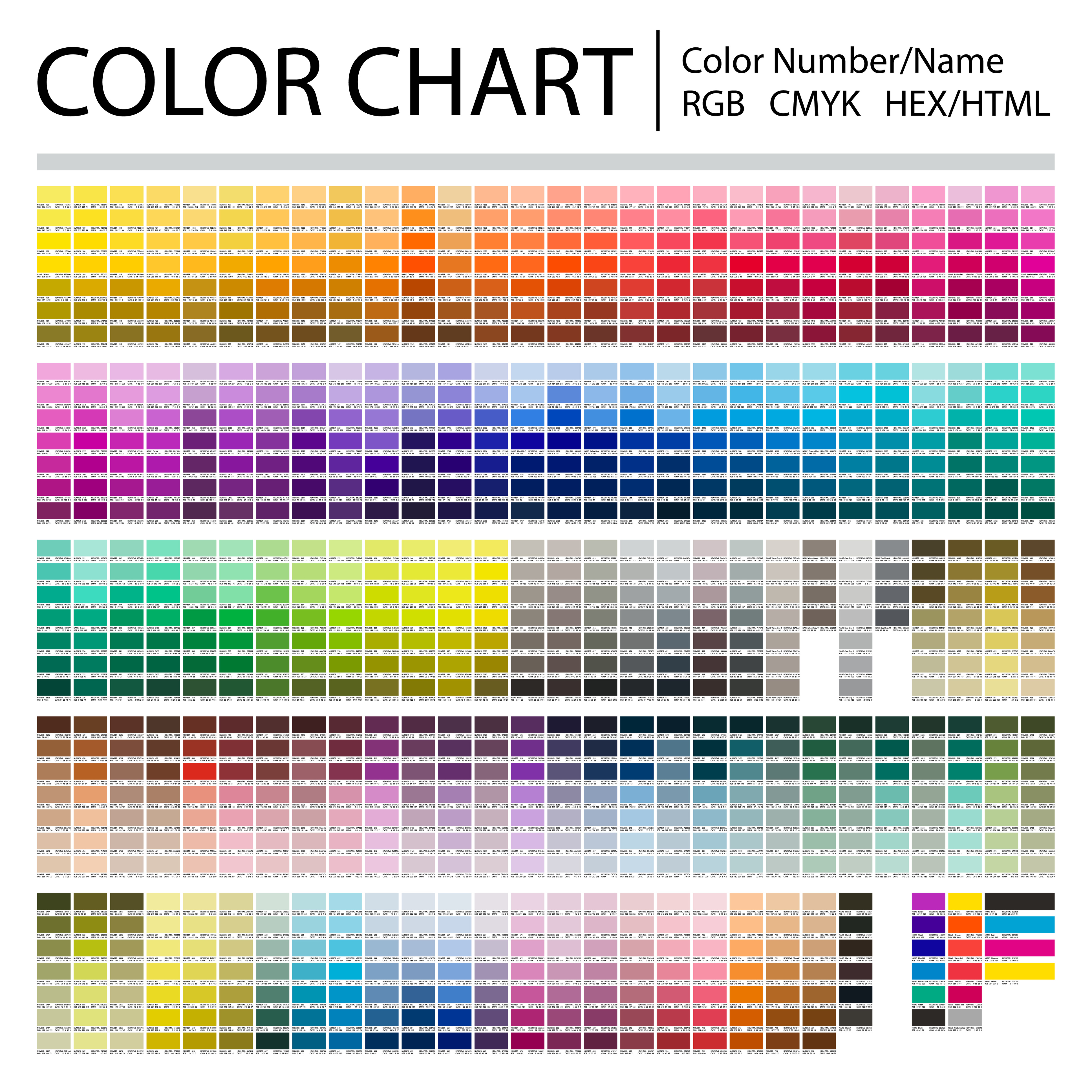
Printing with PMS inks through the offset printing process assures consistent color reproduction. However, because PMS ink colors are specific pre-mixed formulas, they are a significantly more expensive process.
When designers require an absolutely consistent appearance from piece to piece, they rely on Pantone inks. Examples could include packaging, large company brochures, or high-end marketing collateral.
How Process Colors (CMYK) Print Your Brand’s Colors
Process ink colors CMYK—(C) cyan, (M) magenta, (Y) yellow, and (K) black—are applied at the same time in the printing process, that’s why it’s called a four-color process..
Due to the advancements in the science of color and print technology, the cost of this kind of print production has significantly decreased. With lower cost and higher quality than off-set color printing, it makes sense to use it for most marketing print pieces, like full-color booklets, brochures, sell sheets, postcards, and business cards.
By combining overlapping, separate layers of varying screened percentages of each of the four colors, just about any—but not all—PMS color can be replicated. It’s the “but not all” where brands can fall into the murky-print-color-abyss. We can avoid that early in the game with the PMS Color Bridge Guide.
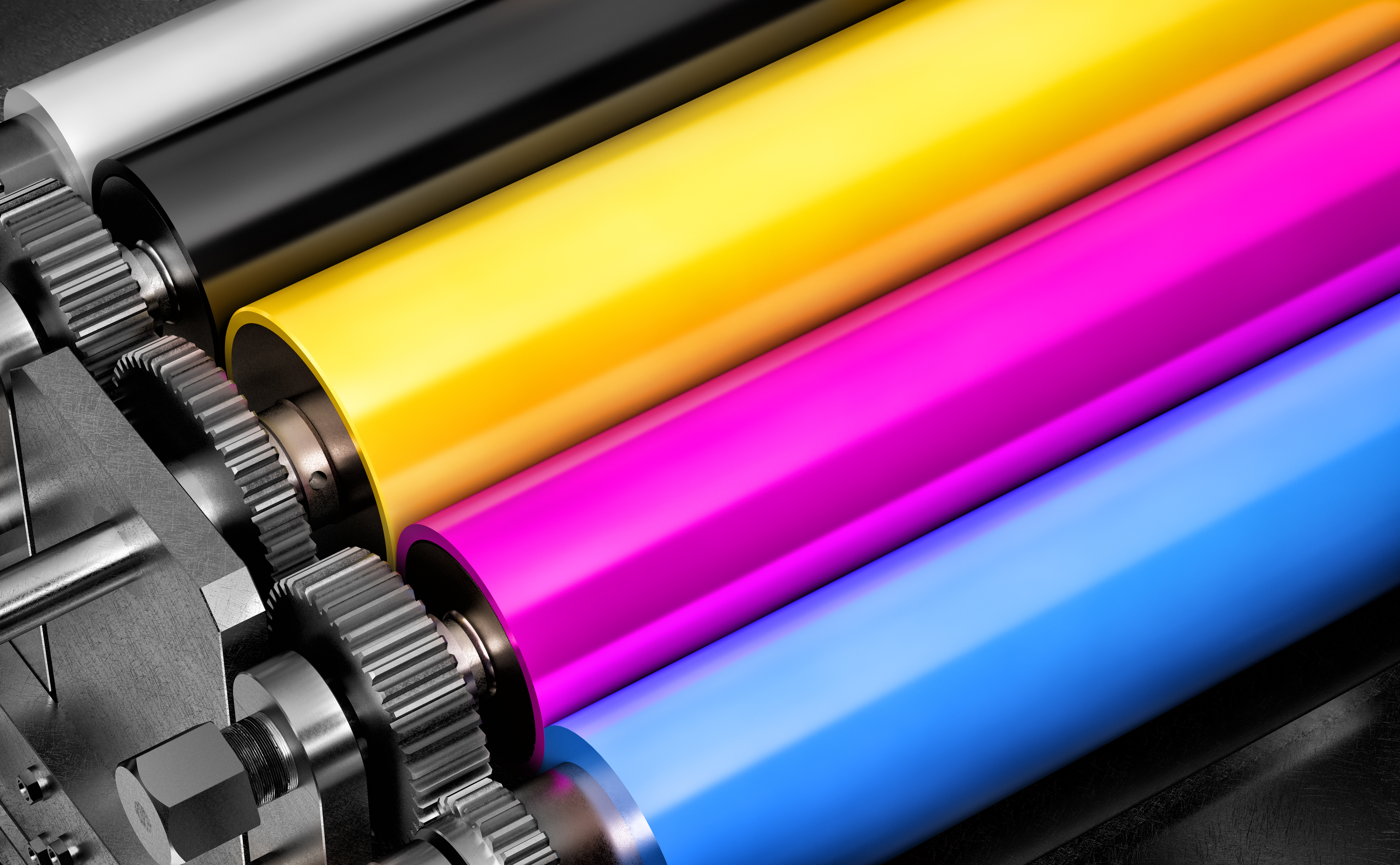
A close-up of a four-color offset printing press with the CMYK inks.
Think Finishing in the Beginning: Rebranding and Your Logo’s Colors
The PMS matching system provides a definitive color system for achieving consistent color results in every application. While process printing with CMYK inks can replicate nearly every color of the spectrum, it has its limitations.
By referencing a printed PMS Color Bridge, you can almost guarantee you’ll get a consistent color when process printing a Pantone color. We advise our clients to select colors that “bridge well.” Colors that appear consistent in both the PMS and CMYK colors will be a good pick for consistent, true color replication for your logo and brand’s color palette.
Using the Pantone Color Bridge
The example below shows how some CMYK colors (on the right) can print much closer to the actual Pantone color (on the left). Other colors are almost impossible to match. When you see a discrepancy in the comparison, it’s time to move on to another Pantone choice.
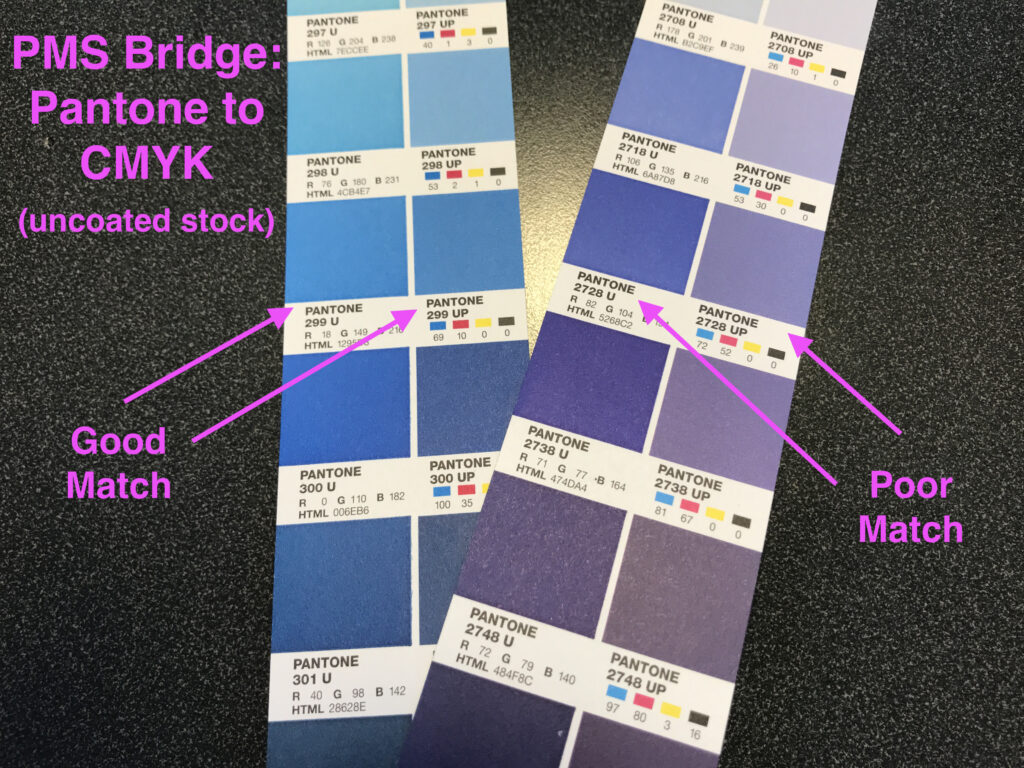
Before you run with a color pick for your company’s brand, reference the Pantone color in the PMS Color Bridge. The Pantone Bridge has color swatches side-by-side: they are examples of what Pantone inks would look like when replicated in four-color process print.
There are two PMS Color Bridge Guides, one for coated paper and one for uncoated paper. You should reference both in your decision-making process.
Consider paper stocks because colors reproduce differently on various paper stocks and finishes.
At some point, every business will need to print its brand colors on both coated and uncoated paper stock. The coated stock has a finish applied to the paper, like gloss, matte, or satin. Colors look brighter on this paper because the ink sits on top of the finish. On uncoated paper, ink is absorbed into it and appears duller by comparison.
Coated stock is popular for marketing collateral like business cards, brochures, presentation folders, labels, sell sheets, and direct mail pieces.
Uncoated stock is preferred for print items like company stationery, shipping boxes, and office printer output.
By comparing both PMS and CMYK color results side-by-side in both coated and uncoated PMS Color Bridge, you will get a clear picture of how well your PMS color will appear in four-color print.
Though printing is never an exact science, the goal for brand consistency is to replicate the PMS color as closely as possible with the CMYK formula.
Achieving Brand Consistency through Color Mastery
By understanding the nuances of color systems and their implications for print and digital media, brands can ensure a cohesive and professional visual identity.
Choosing colors that bridge well between PMS and CMYK, considering paper stocks, and utilizing the Pantone Color Bridge Guide are essential to achieve consistent color reproduction. By implementing these strategies, your company can avoid costly color mistakes and cultivate a recognizable and memorable brand presence across all platforms.

